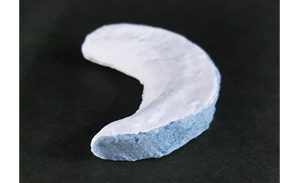September 16, 2021

(Figure: Biodegradable scaffold for meniscal repair)
1. Background
The meniscus is C-shaped cartilage tissue located between the femur and tibia of the knee joint respectively, and acts as a cushion for the knee. Some people suffer from pain during daily life or exercise caused by the difficulty to bend and stretch the knee caused by meniscus damage, which can occur because of injury or degeneration due to aging. In Japan, people with meniscus tears are usually treated by suture surgery. However, if suturing the tear isn’t possible, the only option is to remove the damaged part. By excising the damaged meniscus, the pain is relieved, but there is no longer a “cushion” in that part of the knee. The cartilage of the knee on the femur side may wear down or the bones may grind against each other. As a result, knee function deteriorates, and if symptoms progress, it may be necessary to replace the knee joint with an artificial one.
To solve this problem, Gunze has developed a biodegradable scaffold for meniscal repair for patients suffering from knee pain which was developed by utilizing Gunze's absorbable medical device manufacturing technology together with Dr. Shuhei Otsuki in OMPU. The company has started a project to provide this new treatment to patients. Although there were some difficulties like cartilage tissue being difficult to regenerate in the knees of people who walk upright, and monitoring the relief of pain, the company was able to obtain an approval from the Ministry of Health, Labor and Welfare to conduct an exploratory clinical trial.
2. What is a meniscus scaffold?
The biodegradable scaffold for meniscal repair is created by utilizing our bioabsorbable materials and fiber/polymer processing technology.
The scaffold is cut according to the shape of the patient's injured meniscus and sutured to the patient's own meniscus to fix it. Initially, the scaffold (substitute meniscus) acts as a knee cushion, then the patient's own cells invade the substrate and it becomes their own tissue.
In addition, all the materials are safe synthetic ones that have a long-term track record as medical devices and are expected to reduce the risk of infection.
Previous studies using animals have confirmed that this regenerated meniscus tissue shows almost as the same strength as the original one for approximately one year.
3. Marketing Strategy
After completing the exploratory clinical trials at OMPU, Gunze will confirm and pursue the safety and efficacy of our biodegradable scaffolds for meniscal repair in clinical trials in 2028 and strive to build a sales system aiming for annual sales of 1.2 billion JPY five years after product launch.
Gunze will leverage our strengths in “bioabsorbable materials” and “fiber/polymer processing technology,” to continue improving patients’ QOL through the development and advocacy of less-invasive medical devices and procedures.
Please refer to the original press release here: https://www.gunze.co.jp/english/news/2021/20210916.html
